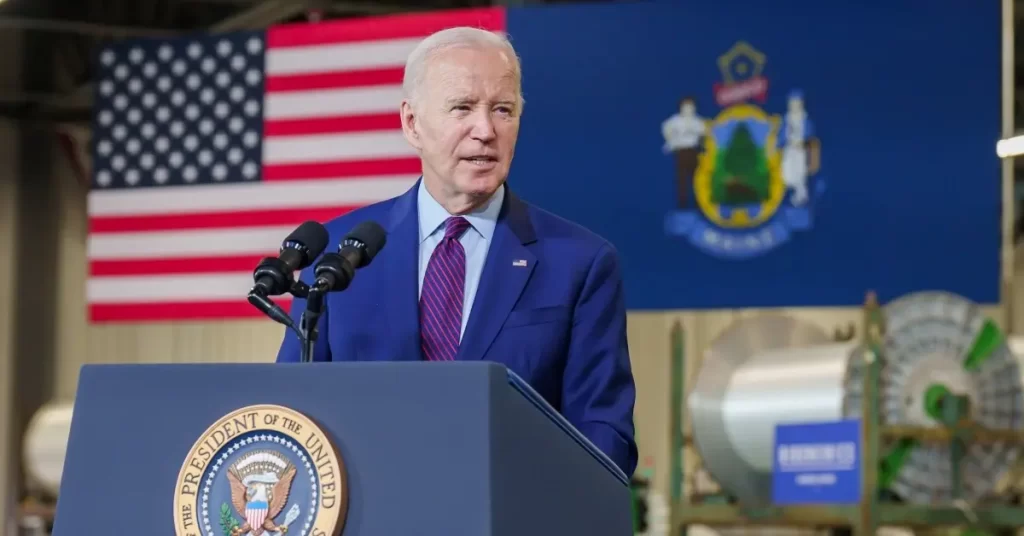President Joe Biden Revives Former President Ronald Reagan Shelved Rule : Construction Workers Get Wage Boost
In a strategic move aimed at bolstering labor unions and addressing wage disparities, President Joe Biden is set to usher in a substantial increase in compensation for construction workers engaged in federally funded projects. This strategic maneuver not only endeavors to resonate with a crucial voter base in anticipation of the upcoming presidential election but also holds the potential to bridge the compensation gap between the northern and southern states.
Embarking on a path that seeks to honor labor unions’ significance, the Biden administration unveiled its intent on Tuesday to reinstate a long-forgotten interpretation of the “prevailing wage” concept—a stance discarded during Ronald Reagan’s administration some forty years ago. The proposed modernization entails a re-calibration of the methodology employed to determine the prevailing wage, subsequently promising to inject thousands of additional dollars annually into the paychecks of construction crews laboring on federal endeavors.
Vice President Kamala Harris, in a resounding declaration at the Finishing Trades Institute in Philadelphia, underscored the urgency of rectifying a situation where workers often receive far less compensation than their labor warrants. She lamented how this discrepancy could translate into substantial monetary losses amounting to thousands of dollars per annum for some. The vice president emphatically condemned this injustice as patently wrong and absolutely unacceptable.
With unwavering determination, Vice President Kamala Harris disclosed that the Biden administration is on the cusp of rolling out a definitive alteration to wage regulations, poised to potentially uplift compensation prospects for construction workers spanning the nation. This revelation arrives amidst the Biden administration’s resolute commitment to channel billions of federal funds into burgeoning clean energy enterprises through the Inflation Reduction Act, an achievement realized in the preceding year. Furthermore, this financial injection extends to the development of infrastructure projects—ranging from roadways to bridges—under a distinct legislative framework.
The dispensation of incentives to companies in politically conservative states—many of which harbor anti-union policies—has skewed the distribution of manufacturing projects in sectors like wind, solar energy, batteries, and electric vehicles, all of which constitute vital components of the clean energy landscape.
However, this dynamic has sparked concerns within organized labor circles, as they apprehensively observe the flow of green employment opportunities into regions characterized by nonunion labor forces. As a means to rectify this anomaly and bolster workers’ financial prospects in such areas, labor groups express fervent support for the wage rule’s revision. The Laborers’ International Union of North America underscores that such an update holds the potential to safeguard the livelihoods of countless construction workers.
At the heart of this transformation lies the concept of prevailing wages—an elemental benchmark encompassing hourly pay rates and associated benefits for workers operating within a specified locality. Before the Reagan era reshaped federal norms in the 1980s, employers were legally obligated to remunerate construction laborers engaged in federal undertakings at levels equivalent to those enjoyed by at least 30% of their peers practicing the same trade within the same geographical domain. Ronald Reagan’s pivot, however, transformed this paradigm, aligning the prevailing wage with that enjoyed by 50% of workers.
With unwavering resolve, President Joe Biden is poised to resurrect the original definition encapsulated within the Davis-Bacon Act, a federal statute originating in 1931. This landmark legislation mandates the adherence to prevailing wage rates for laborers and mechanics engaged in federal or federally assisted construction projects. The ambit of the Davis-Bacon Act extends to encompass over $200 billion worth of federal and federally assisted projects on an annual basis.
Reverting to this earlier definition holds the promise of a closer alignment between federal project wages and those sanctioned within union agreements. Knowledgeable insiders, speaking on the condition of anonymity, emphasize that this modification will uplift the minimum wage requirements, thereby benefiting well over a million construction workers—many of whom lack a college degree.
Experts anticipate that this transformative shift will predominantly favor workers in the southern and southwestern states, including but not limited to Florida and Texas. Historically plagued by comparatively lower wage rates and diminished union protections, these regions stand to gain the most from this new rule.
Amidst the backdrop of this impending alteration, dissenting trade groups proffer their opposition, contending that the revised rule will inevitably translate into escalated taxpayer expenses, rendering federal projects prohibitively costlier.
Ben Brubeck, the Vice President responsible for regulatory, labor, and state affairs at Associated Builders and Contractors, vehemently critiques the proposed shift as yet another instance of the Biden administration favoring organized labor at the expense of taxpayers, small businesses, and the principles of a free market. With a resolute tone, Brubeck hints at the potential for legal challenges, indicating that his group is actively contemplating contesting the rule change through the judicial system.
The process of effecting this rule modification has extended over a year and is slated to take effect within 60 days of its publication in the Federal Register. Yet, the possibility of legal disputes could conceivably prolong this timeline considerably.
In the grand tapestry of policy shifts and political motivations, this pivotal maneuver spearheaded by President Biden holds the promise of reshaping the economic landscape for countless construction workers. As wages potentially rise and disparities begin to narrow, the intricacies of labor unions, clean energy investments, and infrastructure development converge in a nexus that could define the trajectory of the nation’s economic and political narrative.



